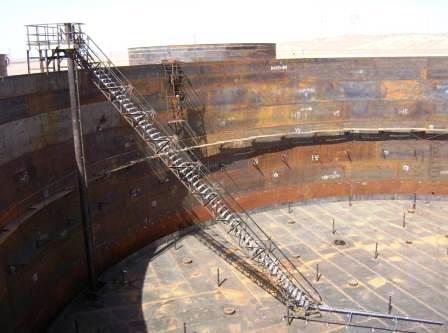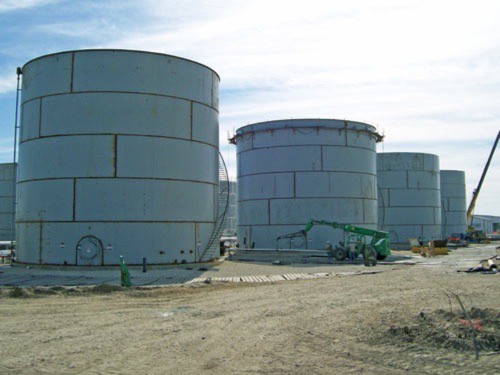Understanding the Relevance of Welding Inspection in Top Quality Assurance Processes
Welding inspection is an essential part of high quality guarantee in building and production. It ensures that welds abide with well established standards, which is crucial for architectural stability. Various assessment techniques, from aesthetic to ultrasonic testing, aid determine defects early. This aggressive technique not just protects against pricey repairs yet also boosts security. Comprehending the subtleties of welding evaluation can disclose its more comprehensive ramifications for market conformity and credibility. API 650 Welding Inspection. What exists beneath the surface of these practices?
The Role of Welding Assessment in Quality Control
While welding is a vital process in different sectors, its quality and stability pivot considerably on reliable examination practices. Welding examination acts as a secure, making certain that welds fulfill established standards and specifications. This procedure not only identifies problems however likewise evaluates the overall workmanship, thereby contributing to the safety and security and long life of bonded frameworks. Assessments are important to top quality assurance, as they help avoid costly failures and maintain conformity with market policies. By employing experienced inspectors, companies can improve their operational performance and maintain their track records. Additionally, the understandings got from assessments can inform continuous improvement, bring about far better approaches and training for welders. Ultimately, welding examination works as a vital web link in the quality guarantee chain, ensuring that every joint is qualified and dependable of holding up against the rigors of its intended application. This diligence is necessary for the integrity of facilities and the safety of end individuals.
Sorts Of Welding Inspections
Welding evaluations incorporate a variety of approaches developed to review the quality and honesty of welds. These inspections are necessary in ensuring conformity with market standards and specs. Common sorts of welding evaluations consist of aesthetic evaluation, which permits immediate identification of surface abnormalities; ultrasonic screening, which utilizes high-frequency acoustic waves to spot interior problems; and radiographic screening, using X-rays or gamma rays to disclose weld honesty under the surface area (API 650 Welding Inspection). In addition, magnetic fragment screening is utilized to identify surface area and near-surface gaps in ferromagnetic materials, while dye penetrant testing provides a technique for revealing surface-breaking flaws. Each kind of evaluation serves a certain objective, adding to the general quality control process. By utilizing a mix of these strategies, assessors can give an extensive evaluation of welding high quality, ultimately ensuring the safety and integrity of bonded frameworks
Usual Issues Discovered in Welding
A range of typical flaws can happen throughout the welding procedure, influencing the stability and efficiency of bonded frameworks. These flaws include porosity, which involves entraped gas pockets within the weld, deteriorating its stamina. Cracks might likewise develop due to rapid air conditioning or inappropriate joint style, leading to possible failure under stress. Insufficient fusion takes place when there is inadequate melting of the base steel, leading to weak bonds. One more problem, damaging, involves the elimination of base steel along the weld edge, developing a considerable structural weakness. In addition, excessive spatter can impact the look and necessitate additional cleansing or repair work. Ultimately, misalignment can cause uneven weld beads, jeopardizing the overall high quality. Determining these issues early through proper examination techniques is vital to assure the reliability and security of bonded parts, webpage ultimately securing the efficiency of the whole framework.

Advantages of Routine Welding Evaluations
Regular assessments play a considerable function in maintaining the top quality and security of bonded frameworks, particularly taking into account the usual problems formerly detailed. These evaluations supply a chance to identify and remedy issues prior to they escalate right into severe problems, making certain structural honesty. By discovering flaws early, companies can minimize repair service prices and prevent possible project delays.
In addition, regular welding assessments enhance compliance with sector standards and home guidelines, fostering depend on among stakeholders. This adherence not only protects the business's credibility but likewise contributes to enhanced safety and security for personnel and the general public.
Consistent assessments assist in far better training and ability growth for welders, as responses from inspections can guide improvements. Eventually, the benefits of regular welding evaluations prolong beyond immediate high quality guarantee, advertising lasting functional effectiveness and dependability in welded structures.
Best Practices for Effective Welding Inspection
Applying finest practices in welding examination is necessary for ensuring the highest possible requirements of quality and safety and security. Assessors should be adequately educated and certified, possessing a thorough understanding of welding methods and materials. Making use of sophisticated inspection modern technologies, such as ultrasonic testing and radiography, boosts the discovery of problems that may not show up to the naked eye. Developing a clear inspection plan, describing the criteria and frequency of inspections, warranties uniformity and thoroughness.

Recording all findings thoroughly is important for traceability and responsibility. Normal calibration of inspection devices ensures precision, while maintaining a well organized and tidy workspace minimizes the risk of contamination. Furthermore, fostering open interaction amongst staff member assists in the sharing of understandings and advertises a society of high quality. By adhering to these finest methods, organizations can notably improve their welding quality control procedures, inevitably causing much safer and a lot more trusted items.

Often Asked Inquiries
What Certifications Are Needed for a Welding Examiner?
A welding inspector normally requires accreditation from recognized companies, such as the American Welding Culture (AWS) or the International Institute of Welding (IIW), along with pertinent experience and knowledge in welding processes and high quality criteria.
How Commonly Should Welding Inspections Be Performed?
Welding assessments need to be performed frequently, commonly at various project stages, including before, during, and after welding processes - API 650 Welding Inspection. The frequency commonly relies on task specifications, regulative needs, and the intricacy of the welds entailed
What Are the Prices Connected With Welding Inspections?
The costs related to welding evaluations vary widely, generally varying from a couple of hundred to numerous thousand bucks, depending upon elements like evaluation type, project dimension, and area, influencing total job budget plans and timelines.
Can Welding Inspections Be Conducted Remotely?
Yes, welding examinations can be performed from another location utilizing advanced modern technologies such as drones, electronic cameras, and ultrasonic screening. These methods allow assessors to analyze weld stability without being physically present, boosting performance and security in various environments.
How Do Examination Results Influence Job Timelines?
Evaluation results can greatly influence project timelines by recognizing flaws early, resulting in essential rework or modifications. Hold-ups may take place if assessments disclose problems calling for resolution, eventually affecting total project conclusion and budget adherence.
Welding inspections incorporate an array of methods made to assess the top quality and integrity of welds. Typical kinds of welding evaluations consist of aesthetic inspection, which enables for prompt identification of surface abnormalities; ultrasonic screening, which uses high-frequency sound waves to detect interior imperfections; and radiographic testing, employing X-rays or gamma rays to disclose weld honesty below the surface. Constant inspections assist in far better training and skill growth for welders, as comments from inspections can lead renovations. Carrying out finest practices in welding inspection is essential for guaranteeing the greatest requirements of high quality and safety and security. Welding inspections must be executed routinely, usually at different job phases, including before, during, and after welding processes.